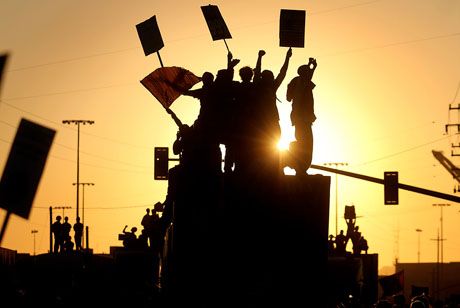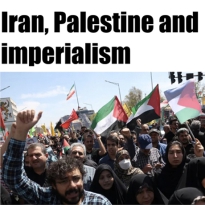Features
You are here
Occupy everything

November 20, 2011
One of the most exciting things about the Occupy protests is the widespread discussion they have sparked, both within the movement itself and among the wider public, about creating resistance to the capitalist system and building alternatives to it. Some of the questions are new. Many others have come up in previous movements. That means today’s movement will have both lessons to offer and lessons to learn.
Strategy and tactics
As the discussions become more sophisticated, activists have had to learn the difference between strategy and tactics, and how they are related. Strategy is the overall plan to achieve a goal. Tactics are the individual steps you take to achieve that goal. The overall strategy should inform the individual tactics.
Discussions about strategy and tactics have been important throughout all the Occupy protests, allowing activists to make short-term decisions based on their long-term goals. For example, in Occupy Toronto, there have been discussions about the link between what activists do on street demonstrations and how they attract more people to participate in the movement. The demonstrations only last a few hours, but they play an important role in generating support for the ongoing occupations, and connecting to broader struggles—as long as they remain open, democratic and inclusive.
Sometimes activists feel impatient with the pace of change and decide to take action on their own—a small group of people acting on behalf of many others. While actions like these might seem to be more radical or militant, they can end up having the opposite effect: excluding others from deciding what action to take, excluding others from participating in the action, and undermining support for the ongoing occupation.
One example of this is the recent attempt by a group of activists at Occupy Oakland to lead an occupation of an empty building once used to house homeless people. The strategy to expand the Occupation movement is a good one, but the tactic used in this case was not. Instead of organizing openly in the General Assembly and winning the whole group to participating in the action, the smaller group attempted to do it on its own, and ended up in a confrontation with the police—without the numbers or support to challenge them effectively. By contrast, the mass march to shut down Oakland’s port, which involved thousands of people who also participated in deciding on what kind of action to take, was a much more effective tactic: it built the confidence of all those who participated, it forced the police off the streets, and it actually shut down the port for a shift, attracting support from dock workers.
Whenever activists discuss what short-term actions to take (tactics), they should always ask whether they support their overall plan (strategy).
Organization
Another exciting discussion has been around the question of organization. Is the movement merely a spontaneous expression of anger against the system? Or does it require organization? If so, what kind of organization would help build the movement effectively?
Some activists have argued that the Occupy protests have no structure whatsoever, that there are no leaders, and that all decisions are made collectively. At some level, this is true of all movements: it takes some time for large groups of people coming together for the first time to figure out the best way to organize themselves.
But structures always emerge, as they are doing now in all of the local occupations. The question is whether those structures will be visible and accountable or invisible and unaccountable.
For example, almost every occupation includes a General Assembly, during which everyone comes together to debate the next steps and update each other on any news or developments. Because of the numbers involved and the thirst for discussing politics, many General Assemblies turn into hours of open discussion without practical conclusions. It is important for people to feel they have a place to have their voice heard, but it is also important for the occupations to make collective decisions. Having committees discuss logistical details, and report back to assemblies for agreement, ensures decisions are made in a collective and accountable way—instead of a small number making decisions behind the scenes an in an unaccountable manner. Some activists celebrate such “de-centralization,” but in reality it is an undemocratic process.
Accessibility
All these questions are related to another important issue: accessibility. In other words, who can participate in the occupations, to what extent can they participate, who makes the decisions and determines the agenda, how can we expand the process to involve more people, what barriers exist to more people getting involved, and so on?
The issue of access takes many forms. In its physical sense, it has to do with who can actually “occupy” the location of the occupation. Although public support for the aims of the protests is high (and continues to grow), the vast majority of ordinary people can’t afford to take time off their jobs or spend time away from their families in order to camp out in a park or plaza with a police presence. But that doesn’t mean they don’t want to get involved or couldn’t participate in another way. In fact, the vast majority of the 99% have yet to join the movement, even if they support it.
Disability
Another important question related to access is disability rights, and one that has developed a profile within the broader Occupy protests. People with disabilities, for example, are “part of the 99%,” but are typically part of its lowest one per cent. In other words, they often experience the effects of austerity and life under capitalism more intensely than others because of countless barriers and discrimination.
In Canada, people with disabilities don’t have decent accessible housing because the government refuses to make it a priority, spending billions on tax cuts instead. In Ontario, 70 per cent of people with disabilities remain unemployed, while the Ontario Disability Support Program is the most steadily increasing item in the province’s budget. Despite some progress—women with a disability are represented for the first time ever in the Official Opposition—but people with disabilities still feel a sense of powerlessness against the capitalist system.
In Toronto, Rob Ford has put accessible transit and social housing on the chopping block, which will have a disproportionate effect on people with disabilities. Ford also cancelled festivities to mark the International Day of Persons with Disabilities, and refuses to address inappropriate police behaviour, including the use of violence, towards people with disabilities.
In order to address these issues, over a hundred people with disabilities and their allies joined a Disability Pride March on October 29. Starting at Nathan Phillips Square, they marched through the financial district to St. James Park, chanting “Equal access, equal rights,” “Build ramps, not bombs,” and “No cuts! No way! Tell Rob Ford: We’re here to stay!” Since then, a similar march has been organized at Occupy Wall Street.
The issue of access has led local occupations to make accommodation a central part of how they organize. At Occupy Toronto, people with disabilities already have the kind of accessible support that would normally take months to receive in their day-to-day lives: attendant care, ASL and accessible portable toilets.
History shows that movements, not just legislation, can more effectively challenge discrimination. Actions like these allow broader movements to connect with the occupy protests.
Anti-racism
Another central question related to accessibility is the issue of racism, and how it affects the participation of people of colour in the Occupy protests. Important debates have emerged about which groups are represented, and which groups are not, among those leading and participating in ongoing occupations. The racialization of entire communities affects the way they experience the effects of neoliberalism and life under capitalism—an experience that is not usually reflected in some of the demands and slogans raised by the occupy protests.
For example, at Occupy Wall Street, during a General Assembly debate about its founding declaration, a number of activists objected to language that glossed over the lived experience of racialized groups, and that claimed the occupiers were “[f]ormerly divided by the colour of our skin” and that “there is only one race, the human race…” The debate that followed began to address the lack of diversity and representation at the occupation, and led to the creation of the People of Color Working Group, whose members call themselves “POCcupiers” and which aims to challenge the way oppression affects the way we organize our resisance to capitalism. Its success has sparked the creation of similar working groups at Occupy Toronto and other occupation locations.
The debate has also helped explain the systemic nature of oppression that exists in all aspects of society. Not suprisingly, this oppression gets replicated in the protests. It’s not a question of just fighting for more representation but of injecting the movement with a critical anti-racist analysis. Likewise, the responsibility to challenge racism must be everyone’s, especially those who have a predominant voice in the process. All of us need to critically assess our privilege and our choices. This approach should apply to challenging all forms of oppression, including sexism, homophobia, transphobia, Islamophobia and others.
Issues such as housing, education, healthcare and employment, for example, are not experienced in the same way from one group to the next; this recognition is a first step to building a more united movement, but one that doesn’t erase or ignore the experiences of racism, racial profiling and bigotry—and all the ways they intensify the effects of neoliberalism and life under capitalism. Exploitation is not the same as oppression; you can’t effectively challenge one without challenging the other.
Similarly, participants have had to address the question of indigenous sovereignty and how the slogan “occupy” might inadvertently reinforce the colonial practice of occupation. From the early days of the movement, indigenous activists have drawn attention to the fact that all the occupations on Turtle Island are, in fact, already on occupied land. Activists have since taken a more sensitive approach to the experience of indigenous people, following their lead on discussions about decolonization and anti-occupation resistance, and informing their strategy with an anti-imperialist critique.
Spreading ‘occupy’
Perhaps the biggest challenge of the occupy protests has been connecting the numbers participating in the ongoing occupations to the much bigger number of people who support the protests but who have not yet found a way to participate. A recent Nanos poll in Canada shows that a solid majority of the public is sympathetic to the occupy movement. Among people under 30, the level of support sits at 73 per cent. Among people over 60, more support the movement than oppose it, although levels of support are lower.
Nevertheless, an audience much bigger than the protests themselves represents the potential for the movement to expand and become more effective. While some activists have argued that the sole focus of the protests should be building the local occupations themselves (including preparing for winter in northern cities), others have argued for a more outward-looking focus—one that takes the spirit, energy and politics of the local occupations to other struggles, as a means to spread the occupy movement.
Where activists have organized actions that connect with other fights against austerity, privatization, lay-offs and cuts, they have had much success. In Toronto, for example, occupy activists have led marches to Ryerson Social Justice Week, and to City Hall to join anti-cuts campaigners—a tactic that ends up building all struggles and the confidence of all those participating in them.
The tactic of spreading occupy protests beyond the protest sites themselves has also had the effect of inspiring occupy protests in other locations, such as on university and college campuses, where students are now beginning to challenge the neoliberal agenda in education.
The movement is also inspiring workers. In Toronto, 1000 postal and steelworkers occupied the main intersection of the financial district under the banner “capitalism doesn’t work for workers” and “postal workers are part of the 99%”. If the protests can spread to workplaces themselves, the movement would be dramatically strengthened, allowing workers to take the lead in directly confronting capitalism: at the point of production.
You can’t evict the movement
The need to spread the occupy protests is more urgent than ever, especially as city officials make plans to evict the occupations, as they have done in London, Ontario and other cities. Activists must prepare both to defend the occupations, preserving the spaces where they have grown and developed over the last few weeks, and to spread them as widely as possible—to workplaces, campuses, neighbourhoods, and so on.
Even if the state does manage to evict the occupations, it can’t evict the movement itself—which is much broader and deeper than the small physical spaces being occupied. The occupy movement is a product of global economic crisis, the inability of social democracy to offer an alternative, and the inspiration from the Arab spring. Attacking people’s freedom of assembly does away with none of these issues, and only confirms people’s sense that—as a placard in Occupy Wall Street read—“the system’s not broken, it was built this way.”
The occupy movement marks the return of the anti-capitalist movement, which will not go away even if it continues in a different form. It has already succeeded in sparking the debate, and encouraging broader struggles, for a better world.
Section:
- Log in to post comments










